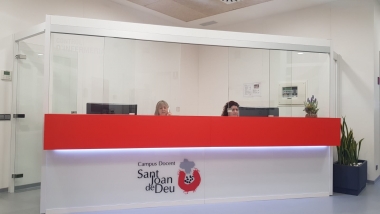The St. Agustí Simulation Center from the Campus Docent Sant Joan de Déu has welcomed the students of the first edition of the "Master on Nursing Cares on the Hospitalized Patient" from the University of Barcelona (UB) for the realization of the clinical simulation module.
The "Master on Nursing Cares on the Hospitalized Patient" was designed to meet the training needs of novel nurses. But also for those who either need recycling for a change on unit or service, or have a broad experience and want to dispose of the latest knowledge based on scientific evidence and train healthcaring with the new available techonlogies.
The UB chose the St. Agustí Simulation Center from the Campus Docent Sant Joan de Déu for the design, development and implementation of the clinical simulation module, thanks to the experience of the team of facilitators on organising similar activities, for the satisfactory experience of previous collaboration between both institutions, the infrastructure and materials in the Center's stock and its location.
The simulation module was conducted for 4 days in which a total of 16 simulation sessions were implemented. During those 4 days, more than sixty simulation scenarios were designed, gathering the most frecuent situations that can happen in the field of hospitalization.
In order to give continuity to the sessions and the contents, 7 simulated patients were ideated, represented by professional actors and manikins. Throughout the sessions, the participants provided a continuum of healthcare to the patients, solving situations of admission, worsening, aggravation, discharge or relocation.
Biomedical clasification of the pathologies explained the reason of admission (respiratory disease, neurological, cardiac, hemodynamic, digestive or surgical, among others), hence the profile of the simulated patient was created in consideration to the characteristics of the community we serve: an aged population, with pluripathology, that lives in complex situations, affected by different health determinants and that has to face ethical problems and dilemmas.
After 4 days of training, in the last session took place the evaluation, based on the method used in the ACOES and that included the resolution of 3 cases.
All activities were led by a team of facilitators constituted by nurses with broad and long experience in the hospitalary field and simulation instructors that managed the sessions, so the student was the protagonist of their learning proccess.
Participants had the chance of training since the first moment, solving doubts as of the practice, and all of that in a safe environment for both the patient and the professional.
The team is thankful to IL3 for the trust deposited and eagerly looking forward the next edition.




